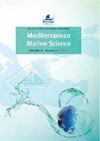Different patterns of population structure and genetic diversity of three mesopelagic fishes in the Greek Seas
IF 2.3
3区 环境科学与生态学
Q1 MARINE & FRESHWATER BIOLOGY
引用次数: 5
Abstract
Mesopelagic fishes are among the most abundant groups of vertebrates on Earth. Despite their unique biological and ecological traits, research in this group has been particularly scarce. The present study investigates the intraspecific genetic diversity of three mesopelagic fishes (Hygophum benoiti, Maurolicus muelleri, and Benthosema glaciale) in the Greek Seas. Analyses of three mitochondrial DNA genes (COI, 12S, and 16S) from a total of 168 samples revealed a lack of genetic structure for M. muelleri and B. glaciale across the studied area. However, H. benoiti specimens from the Corinthian Gulf were differentiated from the rest of the populations, suggesting that the limited connection between the Corinthian and neighboring seas may act as a barrier to gene flow. Furthermore, the COI data of this study were co-analyzed with publicly available sequences, demonstrating lack of phylogeographic structure for all three species through their distribution range. Therefore, even though indications of genetic differentiation were observed, the three mesopelagic fishes are generally characterized by genetic homogeneity, which may be the result of their recent evolutionary history.希腊海三种中上层鱼类种群结构和遗传多样性的不同模式
中上层鱼类是地球上最丰富的脊椎动物群之一。尽管它们具有独特的生物和生态特征,但对这一群体的研究却特别匮乏。本研究调查了希腊海三种中上层鱼类(Hygophum benoiti、Maurolicus muelleri和Benthosema glaciale)的种内遗传多样性。对168个样本中的三个线粒体DNA基因(COI、12S和16S)的分析表明,整个研究区域缺乏穆埃勒里M.muelleri和冰川B.glaciale的遗传结构。然而,来自科林斯湾的H.benoiti标本与其他种群不同,这表明科林斯和邻近海域之间的有限联系可能是基因流动的障碍。此外,本研究的COI数据与公开的序列进行了共同分析,表明所有三个物种在其分布范围内都缺乏系统地理结构。因此,尽管观察到了遗传分化的迹象,但这三种中层鱼类通常具有遗传同质性的特征,这可能是它们最近进化史的结果。
本文章由计算机程序翻译,如有差异,请以英文原文为准。
求助全文
约1分钟内获得全文
求助全文
来源期刊

Mediterranean Marine Science
MARINE & FRESHWATER BIOLOGY-
CiteScore
5.20
自引率
17.90%
发文量
34
审稿时长
>12 weeks
期刊介绍:
The journal Mediterranean Marine Science (MMS), published by the Hellenic Centre for Marine Research (HCMR), issues three volumes annually. The journal welcomes original research articles, short communications, New Mediterranean Biodiversity records, extended reviews, comments, and Theme sections in all fields of Oceanography, Marine Biology, Marine Conservation, Fisheries and Aquaculture in the Mediterranean area and the adjacent regions. All content is peer reviewed.
 求助内容:
求助内容: 应助结果提醒方式:
应助结果提醒方式:


